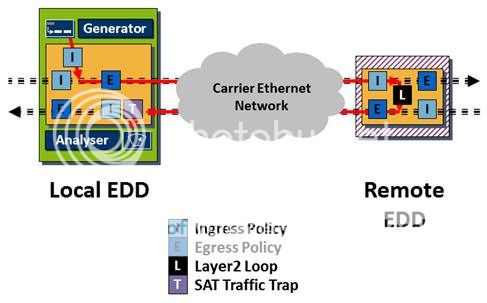Today, many businesses in the financial, insurance, healthcare, R&D, and enterprise industries rely on carrier Ethernet services to transport data. While basic Ethernet connections lack reliability, priority, and guaranteed bandwidth, carrier Ethernet offers a defined quality of service (for example, the operator guarantees a 5 Mb/s end-to-end data rate). Thus, if the network becomes overloaded, the quality of prioritized services won’t suffer. The terms of the service are laid out in a customer’s service level agreement (SLA.) Without an SLA, the service is not guaranteed.

Before a carrier Ethernet connection is activated, the network operator or provider needs to validate the new service to ensure it meets the conditions of the SLA. This involves setting up measurement equipment to test the bandwidth requirements.
This article takes a look at the challenges that network operators face in validating carrier Ethernet services, as well as the benefits and associated workflow of using advanced Ethernet demarcation devices (EDD) integrated with service activation test (SAT) technology.
RFC2544 and Service Test Challenges
When an operator is validating the conditions of a carrier Ethernet service, it’s important that the process be as efficient, cost-effective, and reliable as possible. Traditionally, operators would install loopback and measurement devices on customer premises to test their Ethernet services based on a bandwidth validation standard called RFC2544.
Relying on RFC2544 equipment has several drawbacks. First, RFC2544 was designed to focus on testing a single stream to measure network performance, making it insufficient for multiservice testing. Second, conducting configuration, connectivity, and bandwidth tests with RFC2544 equipment can take several hours. This is a serious issue for operators with tight service maintenance periods. Third, RFC2544 doesn’t measure packet delay variation, which is an important parameter for guaranteeing the quality of real-time services such as VoIP and IPTV. Finally, with RFC2544 equipment, it is difficult to monitor and measure the long-term stability of the service without service interruption.
ITU-T Y.1564: Service Activation Tests
A new bandwidth validation standard called ITU-T Y.1564 dramatically improves upon RFC2544, offering network operators a more efficient and reliable method for testing carrier Ethernet services. ITU-T Y.1564 outlines guidelines for testing the connectivity of an Ethernet carrier service based on performing a Service Activation Test, which analyzes one or more services without interrupting others on the same physical medium. Unlike RFC2544, the new standard works with deterministic parameters like committed information rate (CIR) and excess information rate (EIR) of the used bandwidth profile so that operators can provide a guaranteed quality of service. The CIR means, for example, that an operator guarantees a 5 Mb/s end-to-end data rate. However, it’s not guaranteed that any additional data will be transported. The EIR specifies what additional traffic will be supported as long as there is enough capacity on the network.
The SAT uses artificial traffic generators to simulate a customer’s service based on the expected traffic level. There are two main parts to the SAT: service configuration and service performance tests. The service configuration test examines the correct bandwidth settings and availability of the service. The CIR, CIR and EIR, and traffic overload are tested. The service performance test verifies the service over a certain period of time, typically 24 hours, checking the stability of the SLA over that time period. The resulting parameters are throughput packet number and bandwidth, packet loss, and availability. In addition, timing packets are inserted into the test stream to measure the frame delay and its variation.
SAT also includes testing different specified packet lengths or a mix of defined Ethernet packet sizes. Simultaneous validation of different services is mandatory to test their independence or their queue priority behavior.
Integrating SAT Into EDDs
Prior to SAT, the testing equipment for carrier Ethernet services was expensive. Now, it’s possible to integrate the SAT functionality into EDDs. With many EDDs already installed at customer premises, this would bring massive time and cost savings to network operators.
All that would be required is installing a traffic generator and analyzer function to EDDs, and operators would be armed with a reliable, cost-effective service measurement device. Using an EDD with integrated SAT functionality, operators can perform remote testing and generate reports from a centralized location, such as an operations center.
Modern EDDs are capable of testing the μs time and kbit/s bandwidth resolution of a carrier Ethernet service and running verification tasks without interrupting other services. The service activation test starts on one end of the service via in-band management, and mirrors the SAT loopback on the other end of the service. This enables a full featured end-to-end traffic test of the service.
Aside from performing SATs before the service is activated, continuous monitoring of the service after it has gone live is important. At the end of each month, customers want a report from the operator stating the quality of connectivity. ITU-T Y.1731 defines guidelines for service operation, administration, and monitoring (SOAM), enabling operators to account for any downtimes, packet loss, delay, etc. Combined, SAT and SOAM offer operators a powerful toolbox for installation, supervision, and operation.
The implementation of pass/fail criteria simplifies SAT testing, ensuring that anyone can handle the testing process, whether they have a lot of expertise or very little. The resulting test report can be used as a birth certificate and reference in case there are issues with the service’s life cycle.

Conclusion
Using an advanced Ethernet demarcation device that offers comprehensive carrier Ethernet functionalities, including an integrated SAT suite compliant to the ITU-T Y.1564 standard, operators can more efficiently validate premium Ethernet services. Modern EDDs are capable of injecting and analyzing Ethernet packets probing MEF 10 traffic profiles, as defined by the Metro Ethernet Forum, the official standards body for carrier Ethernet services. Compared to RFC2544 testing, the ITU-T Y.1564 standard allows operators to test a wide range of parameters of the service in one run, rather than UNI bandwidth, frame delay, and interframe delay variation separately.
Furthermore, modern EDDs are capable of supporting loopbacks on a stream basis. From a network operations center, operators can access EDDs via in-band management, remotely establish loopbacks, start validation procedures, and run a 24-hour test without ever needing to travel to the customer premises. When the tests are finished, the operator can run a pass/fail test report and store it directly in a native IT environment, where it can quickly be retrieved if necessary.
This enables operators to focus on different tasks that add value to customers and the business. Customer satisfaction increases, because there is no need to arrange access to the sites and reserve time for testing the service. The existing services are not interrupted while testing the new ones. Finally, after the new service is activated, the switch to the new service tunnel can happen at any time with the operator’s interaction.
The benefits are clear-cut. Implementing SAT testing into the endpoints of the service eliminates time and cost for testing the new service, removes the need for additional measurement devices, and supports automatic test report generation and storage.

